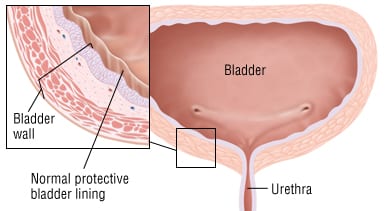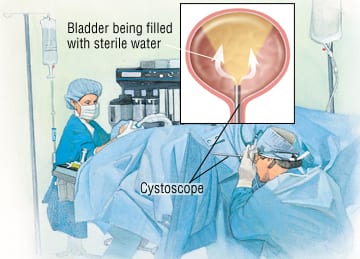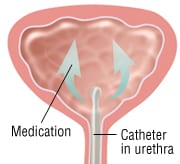Patient Basics: Interstitial Cystitis
Originally published by Harvard Health.
What Is It?
Interstitial cystitis is a puzzling bladder condition, in which the bladder wall becomes irritated or inflamed, causing pain and frequent or painful urination.
The symptoms of interstitial cystitis are often similar to the symptoms of a urinary tract infection. However, in interstitial cystitis, there is no infection, and the symptoms do not respond to antibiotic treatment.
The exact cause of interstitial cystitis remains a mystery, although researchers continue to investigate possible causes, such as unidentified bacteria, an allergic or immune system reaction, a toxic substance in the urine, or a neurological problem in the bladder wall. There also is some evidence that interstitial cystitis may not be just one illness, but several illnesses that share similar symptoms.
Interstitial cystitis usually occurs between the ages of 20 and 50. Approximately 90% of people with interstitial cystitis are women. It is unknown why interstitial cystitis is more common in women. The disease is not known to be genetic (inherited) or caused by toxins in the environment.
Symptoms
Interstitial cystitis may cause:
- Frequent urination
- An intense urge to urinate
- Awakening from sleep to pass urine
- A burning sensation during urination
- Pain, pressure or tenderness in the area of the bladder — midline, below the navel or in some other portion of the pelvis
- Increasing discomfort as the bladder fills
- Pain during sexual intercourse
- In men, pain or discomfort in the penis and scrotum
- In women, worsening symptoms during menstrual periods
Diagnosis
Your doctor will ask you about your urine (urine color, odor, presence of blood), symptoms during urination, any pain you are having, and if you are having fever, nausea or vomiting. Your answers to these questions will provide clues about other possible causes of your symptoms, such as a bladder or kidney infection.
Next, your doctor will examine you and will collect urine from you for laboratory tests that check for signs of infection and infection-causing bacteria. Women usually will need a pelvic exam and men will need a digital rectal exam to check the prostate gland.
There is no one sign or test that can tell you immediately if you have interstitial cystitis. Usually, doctors diagnose the condition after a person has had persistent symptoms and no other cause has been found.
Your doctor probably will refer you to a urologist to help make the diagnosis. He or she will do a test called cystoscopy to look for indications that you have interstitial cystitis and make sure there are no other causes of your symptoms.
During cystoscopy, the urologist uses a small tube like instrument to look inside your bladder and examine its inner lining. In a test called a biopsy a small sample of tissue may be taken from your bladder wall to be examined in a laboratory to look for signs of inflammation and to check for other illnesses, including cancer. During the cystoscopy, your urologist may test your bladder’s maximum capacity by filling it with sterile water. This is to determine whether interstitial cystitis has reduced your bladder’s ability to hold urine.
Expected Duration
How long interstitial cystitis lasts varies. In some people, it is a chronic condition that lasts for many years, while in others, it disappears suddenly. When the condition disappears suddenly, symptoms may return suddenly, even years after the first illness.
Prevention
Since doctors do not know the cause of interstitial cystitis, there is no way to prevent it.
In people who already have been diagnosed with interstitial cystitis, symptoms may be less likely to flare up if the patient quits smoking cigarettes; avoids drinking beverages containing alcohol, caffeine or citrus juice; and avoids eating chocolate, spices or high-acid foods, such as tomatoes and citrus fruits.
Treatment
The goal of treatment is to reduce symptoms. No one therapy is so successful that it should always be tried first. Often a person with interstitial cystitis needs to try several therapies before finding the right combination. The symptoms of interstitial cystitis may go away over time, but there is no therapy that cures the disorder.
Treatments include:
- Dietary modification — Caffeinated beverages, alcohol, citrus fruits, spicy foods and chocolate are just a few in a long list of foods that aggravate interstitial cystitis in some people. Each person needs to discover what she or he needs to avoid.
- Bladder training — In this therapy, patients learn to reduce frequent urination by following a schedule for urinating. The training does not reduce pain.
- Oral medications — Pentosan polysulfate sodium (Elmiron) is the only medication specifically approved for the treatment of interstitial cystitis. About 30% of people with interstitial cystitis have fewer symptoms while taking this medication. Side effects are uncommon.
There is a long list of other oral medications that are not approved specifically for interstitial cystitis, but may offer relief. These include ibuprofen (Advil, Motrin and others); naproxen (Aleve, Naprosyn and others); aspirin; acetaminophen (Tylenol and others); tricyclic antidepressants, such as amitriptyline (Elavil, Endep); hydroxyzine (Atarax, Vistaril); and cimetidine (Tagamet).
- Bladder distention — Sterile water is used to stretch the bladder. Most patients feel worse for a couple weeks after the procedure. After that, 30% to 50% of patients feel better. The beneficial effect lasts only three months, and the procedure is done under general anesthesia, which carries certain risks.
- Bladder instillation (also called bladder wash) — In this procedure, the bladder is filled with a sterile solution containing one of a number of ingredients that work directly on the bladder wall. The solution is put into the bladder through a catheter (hollow tube) that is placed through the urethra. After a variable period of time, the person is instructed to empty his or her bladder. Several active ingredients have been used in this procedure, but DMSO, heparin and topical anesthetics are the ones tried most frequently. As with other therapies, success is variable. Repeating the procedure risks causing more irritation of the bladder wall and introducing infection.
- Electrical nerve stimulation — Traditionally, this has been done with a device called a TENS (transcutaneous electrical nerve stimulator) unit. Mild electrical impulses are passed into the body through wires placed below the navel, on the lower back, or inside the rectum or vagina. The patient controls the timing and intensity of these electrical impulses.
When To Call a Professional
Make an appointment to see a doctor if you are urinating more than usual or feel an intense urge to urinate. If you are having fevers or pain or discomfort, especially in the pelvic/bladder area, penis or scrotum, see your doctor soon.
Prognosis
There is no cure for interstitial cystitis and the prognosis is variable. Many patients find that their symptoms come and go. In some patients, symptoms continue to get worse.
Additional Info
American Urological Association
1000 Corporate Blvd.
Linthicum, MD 21090
Phone: 410-689-3700
Toll-Free: 1-866-746-4282
Fax: 410-689-3800
http://www.urologyhealth.org/



